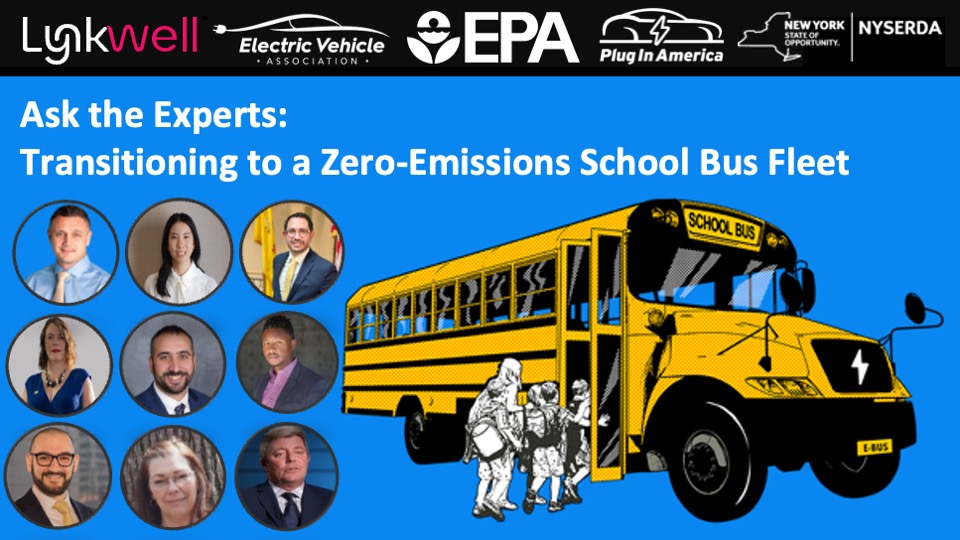4 min read
Key Webinar Takeaways: Exploring School Bus Electrification

In the world of e-mobility, the transition of public school bus fleets to zero-emissions alternatives is prompting discourse. As electric buses gain momentum in schools across the U.S. to reduce emissions, improve children’s health and save money on fuel and maintenance costs, many transportation and school professionals have questions about the procurement, operation and funding of zero-emissions buses.
In a recent panel discussion focused on the transition to a zero-emissions school bus fleet, Lynkwell brought together school and transportation stakeholders with experts from organizations including the Environmental Protection Agency, Plug In America, the New York League of Conservation Voters, the National Electric Vehicle Association and more to answer questions and share pivotal insights related to the electrification transition. If you missed the webinar, you can watch the replay here or read on to unpack the key takeaways.
The Past, Present & Future of Electric School Buses
Brandon Smith, bringing dual experience from non-profit Plug In America and e-mobility organization EVNoire, kicked off the webinar with opening remarks that highlighted the progress made in the electrification of school bus fleets. Smith noted that electric school buses have been around for about a decade, and their popularity has grown as efforts to accelerate electrification and decarbonization efforts are intensified.
Smith pointed out that these buses don’t only serve an environmental initiative, but they have the potential for future-looking technology, like adding resiliency to the electrical grid through vehicle-to-grid technology.
Smith noted the availability of programs and incentives designed to promote the adoption of electric bus fleets, highlighting the need for information and support – a void that organizations such as Plug in America aim to fill.
Public Health and Community Impact
Julie Tighe, the president of the New York League of Conservation Voters, directed our focus to the public health implications of diesel-powered school buses, a major driving factor in the urgency of adopting this advanced technology. Attendees learned startling statistics regarding the high concentration of toxic fumes emitted by these buses that significantly increase cancer risk. Tighe emphasized how transportation pollution disproportionately impacts communities of color, particularly in areas already burdened with high levels of pollution and, thus, higher asthma rates. However, she pointed out that progress is being made, and laws that propel the electrification of school buses are a crucial first step in creating a cleaner environment for school-age children.
The Return on Investment of Electric Buses
Jeremy Johnson from New York Bus Sales provided attendees with his expertise from the perspective of an expert on the operation and maintenance of the buses themselves, elaborating on the potential savings. He noted that a striking 80 percent reduction in maintenance costs compared to internal combustion vehicles is possible, and that his clients usually find that total cost of ownership, including electricity costs, is far more affordable than the repairs and fuel costs associated with a traditional diesel bus.
Navigating Electrification Infrastructure
Will DeRuve of Lynkwell shed light on the crucial infrastructure needed for supporting electric bus fleets. Notably, he discussed the features and benefits associated with Level 2 and Level 3 (direct current fast charging, or DCFC) chargers, pointing out the nuances between the chargers and providing guidelines for the decision-making process.
Importantly, he emphasized the pivotal role of software in overseeing the charging process, a crucial component for any fleet manager. The ability to see real-time data, and adjust operations accordingly, can be imperative for school bus fleet operators.
DeRuve went on to acknowledge that while the thought of electrifying an entire fleet can be daunting, the best approach is to take it one bus at a time. By conducting route analysis and considering on-site power availability, you can determine the most suitable strategies for your fleet’s electrification journey.
The Road Ahead
In conclusion, the insights shared by the panelists underscore the pivotal role of collaboration and education in navigating the transition to electric school buses. Their call to action for engagement with lawmakers, utilities, drivers and advocacy organizations highlights the imperative of unified efforts in advancing EV adoption and pursuing a greener approach to transportation.
Curious about the insights we didn’t cover in this blog? Watch the replay of the full webinar via this link, or peruse our handy e-bus infographic for the basics on zero-emission buses and the infrastructure required to support them.
Related Insights
Discover news, perspectives, education and more from Lynkwell’s team of experts.